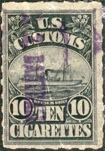Imported Cigar Tax Stamps
A National Cigar History Museum Exclusive
© Tony Hyman
Last stamp added: March 31, 2010

Imported Cigar Tax Stamps
A National Cigar History Museum Exclusive
© Tony Hyman
Last stamp added: March 31, 2010
Cigars have been imported from Europe and Cuba since the 1700’s, and taxed since shortly after the Revolutionary War. It wasn’t until the U.S. Civil War, however, that stamps were issued to put on boxes of cigars to show taxes had been paid.
1864 import
1866 import
1867 import
The stamp issued in 1867 is the same as 1866 but green rather than orange brown. Stamps are almost 13” long. The building is the U.S. Treasury. Although approximately 10,000,000 cigars were imported from Cuba and elsewhere, these stamps are rare, on or off a box. Please contact the Cigar Museum if you find one.
1879 to 1895 & 1895 to 1904 import
Like the excise tax stamps that kept basically the same design from 1878 to 1910, the import stamp issue of 1879 remained in use until 1904 when it was replaced by an entirely new size and design. A minor change took place in 1895 when the requirement to date import stamps was temporarily dropped. The “18___” in the right panel was changed to space for a serial number, printed “No.___.” The 50 denomination was printed in red after 1895 but color did not change on the 25 or 100. The 25 was nearly 10” long and the larger denominations about 13 inches.
1868 to 1871 import
1904 to 1910, 1910 to 1931, 1931 to 1946
Information on the stamp includes serial number, port of entry, means of entry, and typed, stamped or manuscript signature of the inspector. After 1931 inspectors were called customs officers.
The 1904 stamp was issued in 25, 50, 100, 250 and 500 denominations, but as usual larger denominations are almost never seen.
After 1910 denominations were dropped. Import stamps were no longer required after 1946. That means when you find a 1931 customs imported stamp your box dates between 1931 and 1946.
President Grant is a ship in The President Lines, a major international freight and passenger carrier founded in the mid 1800’s and active today with offices in 80 countries worldwide. Names of more than a dozen different Presidents can be found on import stamps. They do not refer to living people, nor are they the purchaser of the cigars as some hopeful ebay sellers have claimed.
1879 and 1903 cigarette import stamps
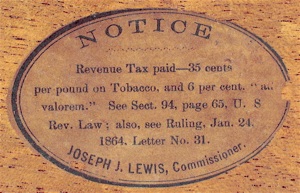



1871 to 1873 import
The issue of 1871-1873 displays a portrait of Ulysses S. Grant, then President of the U.S. The practice of honoring political and other figures on currency, coinage and stamps was later prohibited. Like the previous issue, this one has various commercial counterfeit look-alikes advertising various brands of cigars. I would like buy or photograph any you might find.

1873 to 1875 & 1875 to 1879 import
The imported cigar stamp of 1873 is the first to have denominations, reflecting changes in tax laws. The design of 1873 and 1875 is identical except Harrison replaced Grant in 1875. Color changes on the 25’s but 50’s and 100’s from 73 and 75 are the same color. The 25’s are approximately 10” long, the 50 and 100 nearly 15 inches. All import issues
before 1879 are rare on or off boxes.





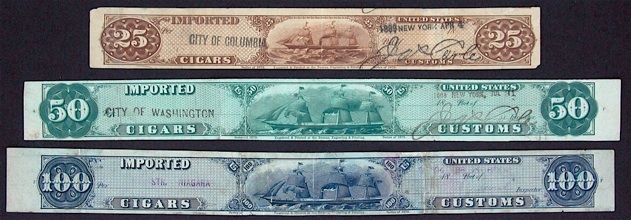
Luggage Searches
Passengers arriving from Havana frequently had their luggage searched from the 1800’s on. When cigars were found in passenger luggage, inspectors were authorized to collect the appropriate taxes and use methods other than standard customs stamp to indicate that taxes were paid.
Both the overprinted stamp and the round rubber cancellation are from 1933 and rare, as is the undated Nogales “port” of entry stamp.
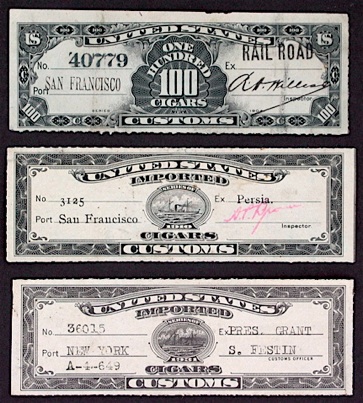




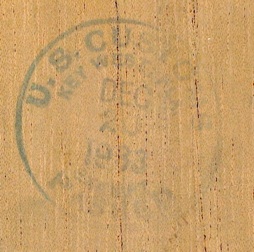
U.S. Customs Manufactured in Bond Stamps:
If you see a US Customs stamp prominently displayed on the top of a box it is usually not an import stamp. Instead, it certifies the cigars were made of Cuban tobacco in a bonded ware-house in Philadelphia, New Orleans, Tampa, New York, Key West or Trenton, NJ. They’re called “Manufactured in Bond stamps,” dated between 1913 and 1953, come in two sizes and are found with various text identifying the type of tobacco and whether hand or machine made.
Bonded warehouses were originally created to cut manufacturing costs of high grade cigars. Import duties on Cuban cigars have always been high. It was much cheaper to import Cuban tobacco and made the cigars in the U.S. The same LA CORONA cigar made in Trenton of Cuban tobacco retailed for half the price of the same cigar made of the same tobacco but made in and imported from Cuba.
Two dates are found on the left side of Bond stamps: Long ones usually read “Act of Oct. 3, 1913” and short ones “Tariff Act of 1930.” The Series date on the right side is the more important as it gives the date a particular stamp was first issued. Series were typically used for a decade or two so Series numbers are not the date of the box.
Beginning with the Series of 1953, Manufactured in Bond stamps were shortened. The design was similar, still authorized for the same half dozen cities, but the descriptions were less descriptive, omitting whether machine or hand made.
The variety of available Manufactured in Bond stamps has never been fully cataloged.
It is sometimes possible to read the date in the perforation cancellations. Watch for upside down and backwards cancellations. For a challenge, try to read the bottom stamp. Hint: the cancellation is in three lines, company, date, place.
The Bock y Ca. box (above) has a 1939 long version Made in Bond stamp. The 1955 La Corona (right) sports the short version.
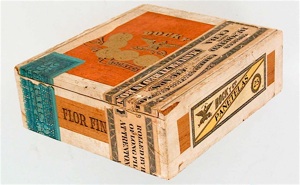
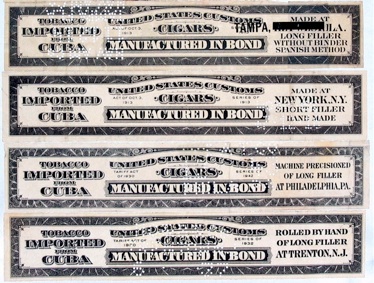
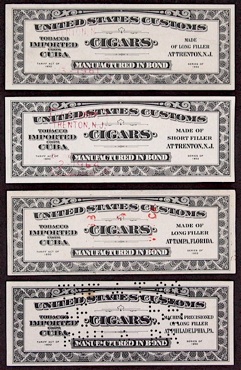
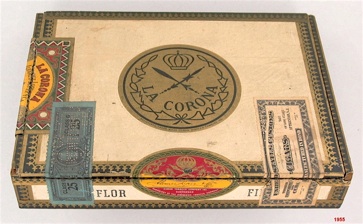
History of Customs Manufactured in Bond Stamps:
With the passage of the Pure Food and Drug law of 1906, many people felt that cigar makers should be banned from falsely using the term “Clear Havana Cigars” for cigars which were not made entirely of Cuban tobacco (which is what the phrase supposedly means). Food and Drug officials refused, basically saying “one form of tobacco was as harmful as another. We will pass laws prohibiting adding weeds or cabbage leaves but we will not dictate the types of tobacco in a cigar.”
Proponents of the ban took a new tack, and in 1913 succeeded in getting the laws governing manufacture in Bonded Warehouses changed. Bonded Warehouses were already a clever tax dodge which permitted cigar companies to import Cuban tobacco without paying taxes, store it in a warehouse, make it into cigars in that same ware-house and then pay tax on the cigars when they left the warehouse. Since taxes on both raw tobacco and finished domestic cigars were much less than on imported cigars this was a huge tax advantage. The new law read:
Since no manufacturer was going to make cigars entirely of tobacco imported from any one country other than Cuba, the effect was a government guarantee that the cigars were indeed Clear Havanas. Clear Havana cigars were not all Made in Bond as most Clear Havana makers didn’t want to adhere to the strict regulations governing Bonded Warehouse-factories. Those cigars that were Made in Bond were permitted to affix the stamp which amounted to a Government Guarantee that they were. Clever.
Initially the long version stamps indicated the manufacturing process used to make the cigars, all well and good in the pre-machine age. As more and more cigars, including mid-price and expensive ones, were machine-made, cigar makers lobbied to have the law changed. Stamps issued after 1953 read whether made of long or short filler but no longer indicate whether hand or machine made.
Both perforated and rubber-stamp cancellations have been permitted since 1913.
Provided, that cigars manufactured in whole of tobacco imported from any one country, made and manufactured in such bonded manufacturing warehouses may be withdrawn for home consumption upon the payment of the duties on such tobacco in its condition as imported, under such regulations as the Secretary of the Treasury may prescribe, and the payment of the Internal Revenue taxes accruing on such cigars in their condition as withdrawn, and the boxes or packages containing such cigars shall be stamped to indicate their character, origin of tobacco from which made, and place manufactured.
In 1879, the first cigarette customs stamps were issued for boxes of 10, 20, 50 and 100. Until 1910, when boxes containing 10 or 20 (usually expensive) Cuban cigars were imported, cigarette customs stamps from 1879 or 1903 were overprinted with the word “cigars” and the quantity (if needed). In 1910, the “All purpose” imported cigar stamp with no denomination was created, eliminating the need for cigarette stamps to be overprinted. The denominations in the two upper corners makes is easy to distinguish between issues of 1879 and 1903.
Above left to right: [1] 1879 import stamp for 10 cigarettes; [2] 1879 import stamp for 20 cigarettes; [3] 1903 import stamp for 10 cigarettes; [4] 1903 import stamp for 20 cigarettes (not available for photo) ; [5] 1903-1910 import stamp for 10 cigarettes overprinted with “CIGARS” used on a box of 10 Cuban cigars. [6] 1879 cigarette customs stamp for a box of 100.
1879 and 1883 cigarette stamps
If you find a cigar box with a long strip stamp for 50 or 100 cigarettes, it does not mean they were imported. The tax office used weight to determine whether a box contained cigarettes or cigars. If they didn’t weigh more than 3 lbs. per thousand, both imported and domestic cigars were classified and taxed as cigarettes. The tax stamps and labels on many small boxes of 50 or 100 19th century domestic small cigars read “cigarettes” or “all tobacco cigarettes” on the label but were actually small cigars. After 1897, small domestic cigars had their own 50 and 100 stamp.
Below top to bottom: Cigarette stamps from 1879 and 1883 found on boxes of small domestic cigars.

The first official “imported cigars” stamp listed in Springer’s Stamp Catalogs is the issue of 1866, but this 1864 sticker/stamp found pasted on a box from that period proves that earlier ones existed.
The 1866 Customs issue is found both plain and with the words “Internal Revenue” crossed out and the word “customs” hand inscribed by the tax inspector.

